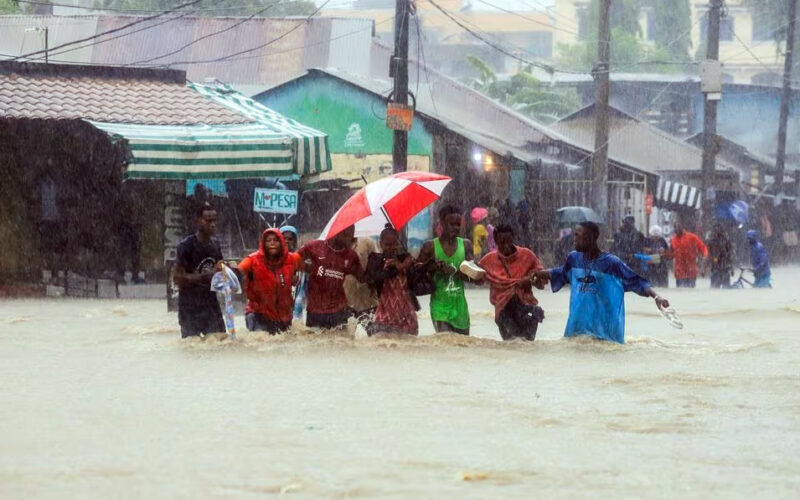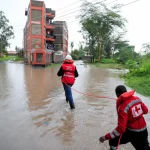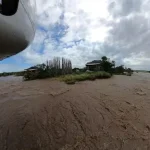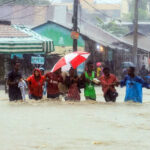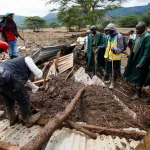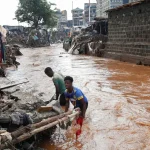THERE were early warnings that Kenya’s long rain season – between March and May – was going to bring above-normal rainfall. The extreme intensity of the rain has resulted in devastating floods in many parts of the country. Forty of the country’s 47 counties have been affected. More than 230 people have died and about 40,000 households, so far, have been displaced.
Poor maintenance of key infrastructure and drainage systems, and disregard of environmental regulations regarding the maintenance of land near rivers, contributed to the situation.
The government has responded with measures to minimise destruction and safeguard lives. These include ordering the evacuation of households living close to dams and water reservoirs in 33 counties and forced evictions of those living near rivers. President William Ruto has also announced welfare support for displaced households.
The effects of the flooding will have a massive impact on Kenya’s economy. I’m a development economist with 20 years of experience in the field of development planning, policy implementation and research. I’ve also worked with the National Treasury and Economic Planning.
I’m particularly concerned about these things: damage done to transport infrastructure, which will affect the prices for goods and services; destruction of crops, which will affect food security; and business losses, which will affect household incomes and consumer purchasing power.
The cost of repairing what’s broken will also have a major impact on the country’s budget, which is already stretched.
The impacts
Infrastructure destroyed
A great deal of infrastructure has been affected.
Besides roads, some dams, airports and water infrastructure will require maintenance.
Floods and a landslide on the railway route between the capital Nairobi and Mombasa forced Kenya Railways to close all cargo services. Nairobi satellite commuter train services were also suspended.
Currently, 58 roads have been reported destroyed. Some of these roads are key highways, such as the Kapenguria-Lokichar-Lodwar highway, Nakuru-Eldoret road and Oletepesi-Magadi road. The Nakuru-Eldoret road also connects Uganda, Rwanda and Congo.
The road disruptions will immediately raise the cost of transport as goods will go via longer routes. This will have an effect on businesses in the transport, wholesale and retail sectors.
The rains have also affected service infrastructure – like water pipelines in Nairobi – and filled dams to capacity. In one tragic incident, a dam in Kijabe burst its banks, flooding villages and killing at least 40 people in the Mai Mahiu area.
The destruction of infrastructure will have a major economic impact. Assessments from the last major flooding in 2018 show that the government had to allocate an extra US$120 million (24% of the budget in the previous year) for repairs and maintenance of road infrastructure.
The repairs weren’t immediate and sometimes weren’t carried out at all. The effects were felt for years.
Cropland destroyed
Kenya’s agriculture sector has also been hit hard. Agriculture is vital to the economy, accounting for about 33% of the country’s GDP and employing 40% of the total workforce. It’s a critical source of livelihood and income for millions of Kenyans.
About 40,000 acres (16,187 hectares) of cropland has already been reported to have been destroyed. In the 2018 floods, it was estimated that about 21,000 acres of crops were destroyed and that was a threat to food security. The impact of the floods on Kenya’s agriculture was substantial, with estimates suggesting billions of Kenyan shillings in crop damage and lost production. Additionally, the floods triggered landslides and soil erosion.
This time, twice as much land is affected. Farmers in affected areas face a total crop failure, their entire livelihoods are washed away. The flooding of 2,000 acres of the Mwea Irrigation Scheme, for instance, is likely to result in losses to the tune of KSh60 million (about US$445,000) in lost crops. This doesn’t include the loss to businesses that would have used the crop.
So far, the basket regions – where most of the staple food production takes place – have been spared the worst of the flooding. However, there is a very high likelihood of perishable crops such as vegetables and pulses recording very low yields. They have shorter maturity and may have been waterlogged or swept away.
The effect on food security will likely be felt much longer. Though Kenya has yet to estimate the effect of the flooding on food production, in Tanzania – which exports food to Kenya – there are estimates that the floods will cause a 30% decline in production this year. Food prices will likely stay high.
Cost to the purse
Kenya’s economy is still recovering from shocks that include high debt distress, global food inflation and exchange rate shock.
The budget estimates for the next financial year reveal that the government has a delicate balancing act in trying to meet commitments as well as stimulating key sectors of the economy.
To cater for emergency response to the flooding situation, the government has forwarded a supplementary budget of Ksh11 billion (about US$80 million) to the National Assembly for approval. This will likely all be spent to provide direct support to households, resettle displaced households and reconstruct infrastructure such as schools and health facilities.
The government is already struggling to meet revenue targets due to a slowdown in economic performance. The total reconstruction will cost much more and will divert resources from other sectors.
Better preparation
Overall, the current flooding will have long-term effects on the economy. The turnaround depends on the choices that policymakers make. A balance has to be maintained between reconstruction efforts and support to productive sectors of the economy, while offering support to those that have been affected.
There is a need to learn from the current disaster to prepare better for the next climate shock.
First, the disaster response of county governments must be strengthened. For instance, stormwater drainage – blamed for much of the flooding in urban areas – is a county government function.
Second, there is a need for better coordination between government and non-state actors to ensure more efficient use of resources to support affected households.
Third, with climate shocks becoming more frequent, there is a need to invest in better weather prediction and early warning systems. Then there must be immediate action on the recommendations from these systems, including training for households in areas prone to disasters.
Fourth, better planning in urban settlements is needed. This includes proper maintenance of roads, bridges and drainage infrastructure, adherence to building codes and standards and environmental regulations – such as protection of riparian lands.
Finally, investing in generating and creating access to data can help to inform responses and improve planning for reconstruction after disasters.
TIMOTHY NJAGI NJERU, Research Fellow, Tegemeo Institute, Egerton University
- This article is republished from The Conversation under a Creative Commons license. Read the original article.

